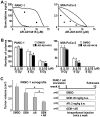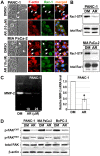Aberrant glycogen synthase kinase 3β is involved in pancreatic cancer cell invasion and resistance to therapy
- PMID: 23408967
- PMCID: PMC3568118
- DOI: 10.1371/journal.pone.0055289
Aberrant glycogen synthase kinase 3β is involved in pancreatic cancer cell invasion and resistance to therapy
Abstract
Background and purpose: The major obstacles to treatment of pancreatic cancer are the highly invasive capacity and resistance to chemo- and radiotherapy. Glycogen synthase kinase 3β (GSK3β) regulates multiple cellular pathways and is implicated in various diseases including cancer. Here we investigate a pathological role for GSK3β in the invasive and treatment resistant phenotype of pancreatic cancer.
Methods: Pancreatic cancer cells were examined for GSK3β expression, phosphorylation and activity using Western blotting and in vitro kinase assay. The effects of GSK3β inhibition on cancer cell survival, proliferation, invasive ability and susceptibility to gemcitabine and radiation were examined following treatment with a pharmacological inhibitor or by RNA interference. Effects of GSK3β inhibition on cancer cell xenografts were also examined.
Results: Pancreatic cancer cells showed higher expression and activity of GSK3β than non-neoplastic cells, which were associated with changes in its differential phosphorylation. Inhibition of GSK3β significantly reduced the proliferation and survival of cancer cells, sensitized them to gemcitabine and ionizing radiation, and attenuated their migration and invasion. These effects were associated with decreases in cyclin D1 expression and Rb phosphorylation. Inhibition of GSK3β also altered the subcellular localization of Rac1 and F-actin and the cellular microarchitecture, including lamellipodia. Coincident with these changes were the reduced secretion of matrix metalloproteinase-2 (MMP-2) and decreased phosphorylation of focal adhesion kinase (FAK). The effects of GSK3β inhibition on tumor invasion, susceptibility to gemcitabine, MMP-2 expression and FAK phosphorylation were observed in tumor xenografts.
Conclusion: The targeting of GSK3β represents an effective strategy to overcome the dual challenges of invasiveness and treatment resistance in pancreatic cancer.
Conflict of interest statement
Figures







Similar articles
-
Glycogen synthase kinase-3β participates in acquired resistance to gemcitabine in pancreatic cancer.Cancer Sci. 2020 Dec;111(12):4405-4416. doi: 10.1111/cas.14668. Epub 2020 Oct 12. Cancer Sci. 2020. PMID: 32986894 Free PMC article.
-
Glycogen synthase kinase 3β inhibition sensitizes pancreatic cancer cells to gemcitabine.J Gastroenterol. 2012 Mar;47(3):321-33. doi: 10.1007/s00535-011-0484-9. Epub 2011 Nov 1. J Gastroenterol. 2012. PMID: 22041920
-
Glycogen synthase kinase 3β sustains invasion of glioblastoma via the focal adhesion kinase, Rac1, and c-Jun N-terminal kinase-mediated pathway.Mol Cancer Ther. 2015 Feb;14(2):564-74. doi: 10.1158/1535-7163.MCT-14-0479. Epub 2014 Dec 10. Mol Cancer Ther. 2015. PMID: 25504636
-
An emerging strategy for cancer treatment targeting aberrant glycogen synthase kinase 3 beta.Anticancer Agents Med Chem. 2009 Dec;9(10):1114-22. doi: 10.2174/187152009789734982. Anticancer Agents Med Chem. 2009. PMID: 19925395 Review.
-
Glycogen synthase kinase-3β is a pivotal mediator of cancer invasion and resistance to therapy.Cancer Sci. 2016 Oct;107(10):1363-1372. doi: 10.1111/cas.13028. Epub 2016 Sep 24. Cancer Sci. 2016. PMID: 27486911 Free PMC article. Review.
Cited by
-
An Inhibitor of GSK3B and HDACs Kills Pancreatic Cancer Cells and Slows Pancreatic Tumor Growth and Metastasis in Mice.Gastroenterology. 2018 Dec;155(6):1985-1998.e5. doi: 10.1053/j.gastro.2018.08.028. Epub 2018 Aug 23. Gastroenterology. 2018. PMID: 30144430 Free PMC article.
-
Characterisation of resistance mechanisms developed by basal cell carcinoma cells in response to repeated cycles of Photodynamic Therapy.Sci Rep. 2019 Mar 18;9(1):4835. doi: 10.1038/s41598-019-41313-y. Sci Rep. 2019. PMID: 30886381 Free PMC article.
-
Colorectal cancer cells require glycogen synthase kinase-3β for sustaining mitosis via translocated promoter region (TPR)-dynein interaction.Oncotarget. 2018 Jan 30;9(17):13337-13352. doi: 10.18632/oncotarget.24344. eCollection 2018 Mar 2. Oncotarget. 2018. PMID: 29568361 Free PMC article.
-
Glycogen synthase kinase-3β participates in acquired resistance to gemcitabine in pancreatic cancer.Cancer Sci. 2020 Dec;111(12):4405-4416. doi: 10.1111/cas.14668. Epub 2020 Oct 12. Cancer Sci. 2020. PMID: 32986894 Free PMC article.
-
Modulation of glycogen synthase kinase-3β following TRAIL combinatorial treatment in cancer cells.Oncotarget. 2016 Oct 11;7(41):66892-66905. doi: 10.18632/oncotarget.11834. Oncotarget. 2016. PMID: 27602497 Free PMC article.
References
-
- Siegel R, Naishadham D, Jemal A (2012) Cancer statistics, 2012. CA Cancer J Clin 62: 10–29. - PubMed
-
- Bardeesy N, DePinho RA (2002) Pancreatic cancer biology and genetics. Nat Rev Cancer 2: 897–909. - PubMed
-
- Li D, Xie K, Wolff R, Abbruzzese JL (2004) Pancreatic cancer. Lancet 363: 1049–1057. - PubMed
-
- Hidalgo M (2010) Pancreatic cancer. N Engl J Med 362: 1605–1617. - PubMed
-
- Furukawa T (2008) Molecular targeting therapy for pancreatic cancer: Current knowledge and perspectives from bench to bedside. J Gastroenterol 43: 905–911. - PubMed
Publication types
MeSH terms
Substances
LinkOut - more resources
Full Text Sources
Other Literature Sources
Medical
Research Materials
Miscellaneous

